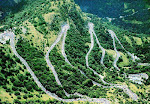I'd argue that this apparent compulsive hoarding is in no way a sign of mental illness (I think he doth protest too much), but rather no more than a harmless extension of Obsessive Compulsive Cycling Disorder - a book I'm currently reading by Dave Barter. It's a much-valued accumulation over the years of a wide variety of printed matter, chronicling my love for this beautiful sport. No-one in their right mind would throw out family photographs, and these items are similarly capable of engendering a deep emotional response in me.
------------------------------------------------------------------------------------------------
It ran like this: if you wanted to be a pro, you’d need to go and live and race abroad and speak the language. We’d all heard the numerous broken-dream stories of talented Brits in France who’d returned early, simply unable to cope. I don’t know which came first for me – the love of the language or my boyish cycling dreams – but whichever it was, when my French teacher urged us to listen to French radio, read novels and newspapers like Le Monde, I had a plan. In the mind of a 15-year-old Francophile, tuning in to long-wave radio to catch the results of a Dauphiné Libéré stage was a brilliant idea, and Baudelaire, Balzac or dreary business journalism could quite reasonably be substituted with magazines like Vélo, Miroir and Sprint. Here was stuff I actually wanted to read.
This was an era when Cycling Weekly was our only access to the ‘continental scene’, the occasionally inspiring cover removed and blu-tacked to the bedroom wall, the perfunctory journalism inside simply skim-read and discarded. This novel French reading matter from Charing Cross Road was different. Out of habit I similarly defaced my first copy of Miroir – a picture of Hinault in yellow – and regretted it the moment I did it. What had I done? Transformed into something to cherish, the evocative photographs and poetic writing meant that there was no way further acquisitions could be mutilated like this. The Collector was born.
I was transported into a world of cycling wonderment: Le Coq Sportif yellow and Chocolat Poulain-sponsored polka-dot jerseys, Gitane bikes and Merlin Plage banners, red Peugeot commissaire’s cars blasting out their distinctive klaxons and flashing their headlights as the winner crossed the line. The voice in my head as I read is Daniel Mangeas, Le Speaker du Tour.
These first copies are my favourites, with riders unsullied by sponsors sunglasses and logo-plastered helmets, displaying instead an almost quaint parochial amateurism, of minimal sponsorship and commercial interests, where quintessentially French characteristics stand out. There’s a much-missed simplicity where the honest, human emotions of the riders are centre-stage: the intensity of effort, the unyielding focus on victory - la rage de vaincre - and the contrasting joy and disappointment of winner and losers alike.
As time has passed so the collection has grown, carefully stored in the loft and removed for occasional reminiscing. More than just a record of how cycling has changed over the years, they’ve become a poignant reference to moments in my own life: of exciting foreign adventures where they were purchased and poured over, of new places and people, of growing up, and like the fading images of the riders inside, of inevitably growing older.
I remember where I was when I bought a specific issue, what I was doing, who I was with. Pascal Simon grimacing up Le Puy-de-Dôme with a broken shoulder blade when perhaps I should have been revising harder. First-kiss butterflies of a new relationship, whilst Jean-Francois Bernard hauled himself to the top of the Ventoux faster than everyone else. Cowering inside a rain-sodden bar at Les Deux Alpes reading about that day’s stage in L’Equipe, whilst outside Marco simply rode away from everybody.
Whilst deep-down I had no real hopes of becoming a pro, language study took me to University with a year in southern France, and a chance at the very least to pretend to be a rider. The irony of getting my name into Vélo in 1988 simply for being a coureur Britannique riding in a French team, obviously the next Stephen Roche, was not lost on me. My personal triplé for the season consisted only of a nut-brown cyclist’s tan, French now spoken with a Pagnolesque Provençal twang, and a sizeable overdraft.
These riders were my boyhood companions, people I identified with, sartorially imitated on the bike and somehow wanted to be. Flicking through the magazines is like looking back at a family photo album you wish you were somehow in. Then they were daredevil uncles, today energetic young nephews, but both heroically competing in the hardest sport in the world, a sport I had neither the ability nor courage to pursue to their level, on the only stage that’s ever counted for me: Europe. The images and words captured inside are a celebration of this honesty, depicting la noble incertitude du sport - the magnificent uncertainty of sport. Sport is surely a metaphor for life, and this prized collection of magazines additionally represents a valued narrative of my own existence.






